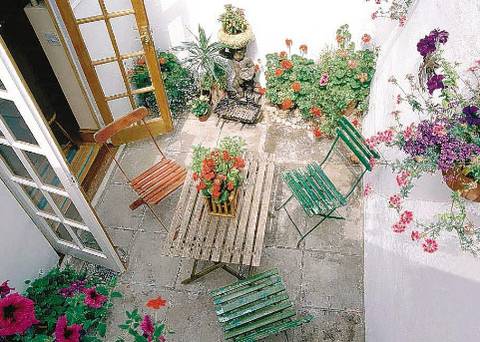The simple way to manage pots is to pack each one full of whatever you fancy – tulips, wallflowers, lilies, agapanthus, petunias – and then shunt the pots round in different combinations, depending on what is in flower. You might group pots of wallflowers with a pot of the fabulous scented tulip ‘Ballerina’ and another of a red tulip such as praestans ‘Fusilier’. You could try ‘New Design’ (an orange/yellow tulip, flushed with pink and green) with tubs of forget-me-nots.
But now, at the beginning of May, we need to be thinking ahead, planning the displays that will take these pots all the way through summer. Lilies, for instance, can be raised in pots in some hidden part of the garden, then wheeled into the limelight when they are ready to face it. Like tulips, lilies grow very well in containers and since, again like tulips, they have nothing much to offer when they are out of flower, keeping them portable is an advantage.
Elsewhere, you might treat pots differently. If there is one large pot in a prominent place, you can think of it as a miniature garden in which you can mix plants as you would in a flower border. This is a more complicated trick to carry off. You need to think not only about colour combinations, but also about the way each plant grows and its relative vigour. Is the pot in sun or in shade?
This is my starting point in thinking about plants for summer pots. Many good container plants – fuchsia, diascia, helichrysum, ivy-leaved geraniums, nemesia, variegated plectranthus, verbena, bacopa – are obliging enough to thrive in sun or half-shade. Others, such as blue-flowered Convolvulus sabatus, argyranthemums in pink, white or pale yellow, gazanias such as ‘Pomegranate’, and the pretty dianthus called ‘Raspberry Sundae’ need full sun.
Once you’ve got plants clearly sorted in your mind with regard to sun and shade, you need to balance foliage and flower. Pots must look generous in their planting and for this you need plenty of good leaf. Choose variegated plectranthus or nepeta, both of which trail elegantly out of pots and hanging baskets. Helichrysum, whether grey, lime or variegated, is stiffer in growth and more likely to swamp its neighbours. But grey helichrysum looks good with blue convolvulus as long as you are prepared to trim back the helichrysum from time to time.
Ivy-leaved geraniums are also naturals because the foliage is strong and chunky and so makes a pot seem well-filled. They drift elegantly over the edges, too. There is no shortage of good ones: ‘Madame Crousse’, a bright-pink double, ‘Yale’ a rich-red semi-double, ‘Rouletta’ which is white edged with red. Use them with petunias and add height, if you wish, with a fuchsia in the middle.
For foliage fillers, I also use scented-leaved geraniums such as ‘Candy Dancer’, which has deeply serrated leaves and smells strongly of lemon. ‘Sweet Mimosa’ has decent-sized flowers of a deep, rich pink but these aren’t geraniums to grow primarily for flowers. They give bulk and an endless supply of leaves for infusions, either to drink or to put in the bath. ‘Pink Capitatum’ is fantastically prolific. All these scented-leaved pelargoniums are easy to strike from cuttings and overwinter. I put the leftover ‘Pink Capitatum’ plants in terracotta pots on the landing window sill and they grow there as happily as they do outside.
Foliage gives the necessary air of generosity in a pot but, of course, you need flowers that have a long season, too. You see certain plants cropping up again and again in pot mixes: lobelia, argyranthemum, felicia, yellow daisy-flowered bidens, blue brachycome, osteospermums, various verbenas, such as ‘Homestead Purple’ or the paler ‘Aztec Silver Magic’. They are used again and again because they work and the fact that they are popular is no reason not to use them.
The first argyranthemum I ever grew was ‘Jamaica Primrose’ and because it’s easy to strike from cuttings, I’m still growing it. It’s very vigorous, with grey, deeply serrated leaves and an endless supply of flowers in an easy, soft lemon-yellow. The bigger the pot, the bigger the plant will get, and when I set them out (mid-May here in the south, but it would be later in the north), I stake the main stems with bamboo canes. Without this support they snap in the wind. There are whites, such as ‘Snow Storm’ as well as various pinks, but I stick to ‘Jamaica Primrose’ because it looks so good with the blue of petunia, calibrachoa or lobelia.
A pot is a good way of emphasising the importance of a plant in a mixed planting. If you have a slightly sleepy sea of greys and whites and pale greens in a bed, you can introduce a pot into the middle of the planting, with perhaps a melianthus or a yucca or a cordyline in it. It adds drama and the pot lifts the plant on to a different level. But a plant used in this way needs to be a good specimen, well grown. Putting it in a pot draws extra attention to it.
The best plant I ever used in this way was Gladiolus murielae (it used to be called acidanthera), a tall, graceful plant with a succession of white, slightly dropping flowers, each with a thrilling dark eye. It starts performing in late August and smells heavenly. Bulbs should still be available in garden centres to plant now.
There is an advantage in using a loamy compost, such as John Innes No 3 for filling pots. The weight that makes it such a pain to hump home from the garden centre later becomes an advantage, because it makes your pots more stable. It also hangs on to nutrients better than soilless composts. For feeding, I use a slow release fertiliser such as Osmocote (the planter’s plant food). It breaks down very slowly to supply everything the plants need by way of food through the summer.
View this and more articles on the Belfast Telegraph.




